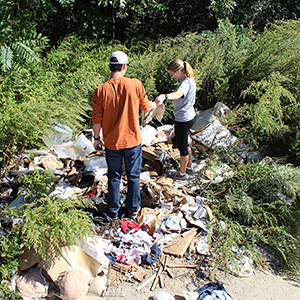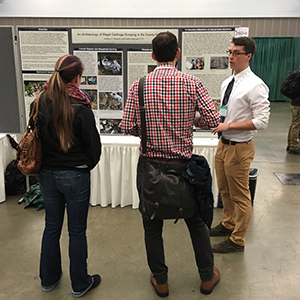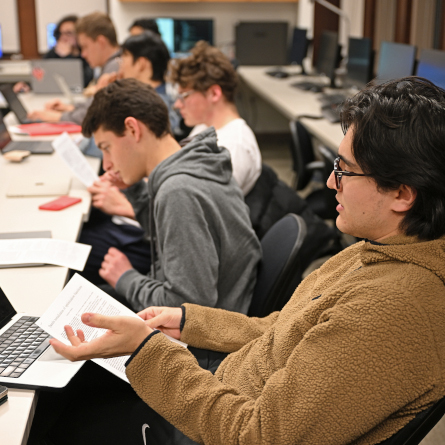
Faculty-student research explores the archaeology of illegal dump sites

For most, archaeology is recognized as the discipline in which scholars study ancient societies using the remains of material culture. But what if archaeologists marshaled the discipline’s unique set of investigatory methods and analytic lenses to the study of the present?
This question is at the heart of a recently published study exploring the acts and motivations of present-day discard behavior—particularly with regards to illegal dumping sites—conducted by Associate Professor of Anthropology Anthony Graesch and his then-undergraduate student researchers Corbin Maynard ’17 and Avery Thomas ’16.
“Landfills have garnered a great deal of popular and scholarly attention, but other materializations of discard behavior remain under-investigated or altogether ignored,” Graesch said. “This faculty-student research project was designed to investigate discard at the fringes of otherwise familiar forms of municipal waste handling, or that which can be regarded as illicit and often invisible.”
The researchers conducted an 85-mile roadside survey that included seldom-trafficked streets, dead-ends, abandoned lots, underpasses, bridges and utility easements. Their efforts revealed 22 unsanctioned dumping events at five different sites in the greater New London area. The team mapped, photographed and catalogued several hundred artifacts with techniques that would otherwise be applied during the archaeological study of more ancient cultures.
“Not only was the sheer volume of data collected intriguing, but the material we found was fascinating, from photo albums to wedding dresses. The personal nature of all the information we recorded and gathered was shocking; we could easily identify these people and constructed a fairly solid idea of their histories and connections,” said Maynard, who majored in anthropology and classical studies and is now an assistant director of admission at Conn.
“It is absolutely amazing what people throw away, and exploring the ideology behind why the items were tossed was a fun part of the process.”
The research appears as an invited chapter, “Discards, Emotions, and Empathy on the Margins of the Wastestream,” in a newly published volume, Archaeologies of the Heart, which brings to together scholars whose work addresses feminist, Indigenous, activist, community-based and anarchic critiques of how archaeology is practiced, and also examines how science is used to interpret the past and present lives of people. Their chapter explores some of the emotional dimensions of discarding personal possessions, but also the affective experiences of fieldworkers who document these possessions in illegal dumps.

Graesch often designs his courses around faculty-student research programs, and the archaeology of present-day discards has figured prominently in some of his recent work. In the fall, he offered a new first year seminar, “#WasteStream Archaeology,” which focused on the social history and archaeology of the post-18th century waste stream in North America. In the spring, he instructed a new upper-level seminar, “Discard(-ers)(-ing)(-ables),” which explored present-day discard-related phenomena, including notions of disposability, sources and forms of food waste, household purges of belongings, cigarette littering, low-orbit space trash and more. Cross-listed with environmental studies, the interdisciplinary course attracted student participants majoring in environmental studies, anthropology, computer science, psychology and government.
As part of the spring seminar, Graesch gave Jenny Carroll ’20 and her classmates each a Solo hot cup, much like the ones used in coffee shops across campus. The students were asked to use the disposable cup every day for two weeks, then write a cultural biography about the object.
Having previously taken Graesch’s “Material Legacies,” Carroll had some idea of what to expect.
“I was fully prepared for this project to make me more aware of how I use mundane objects, as well as how frequently they pass through my life,” said Carroll, an archaeological anthropology major and art history minor within the Museum Studies Certificate Program from Waterford, Connecticut.
Students carried the cups around campus for the two weeks prior to Spring Break, then completed the biographies once classes went remote.
“This style of cup is marketed as single-use and is accepted as such, yet it can be used for much longer before it should be culturally understood as ‘waste,’” said Carroll, who will attend the Museum Education Graduate Program at Tufts University this fall.
“Even after the assignment was over, I felt bad at the prospect of throwing away the cup because it was still in such good condition, so I ended up planting extra thyme seeds I had from Spring planting. Ironically, the thyme I planted in some small coconut fiber pots all died, but the thyme planted in the coffee cup is doing amazing.”
Graesch says a great deal of attention in anthropology and archaeology has been accorded to the domains of production and consumption, while comparatively less attention is given to domains of discard or object riddance.
“This seminar encourages participants to depart from the moralizing and often facile manner in which present-day discard and waste are often discussed and, instead, to focus on building more complex, critically analytic understandings of the ways we sever relationships with our belongings, particularly in the context of modern capitalism and Internet-era lifeways.”
